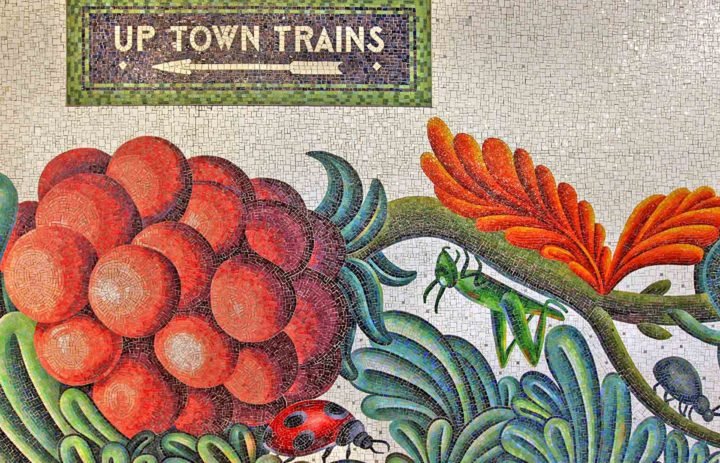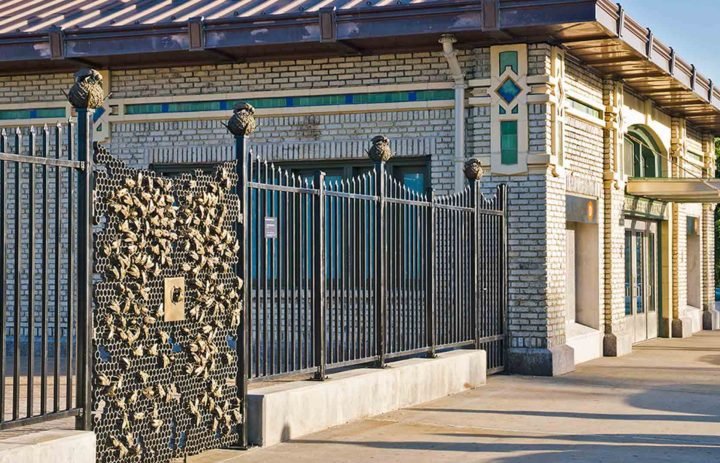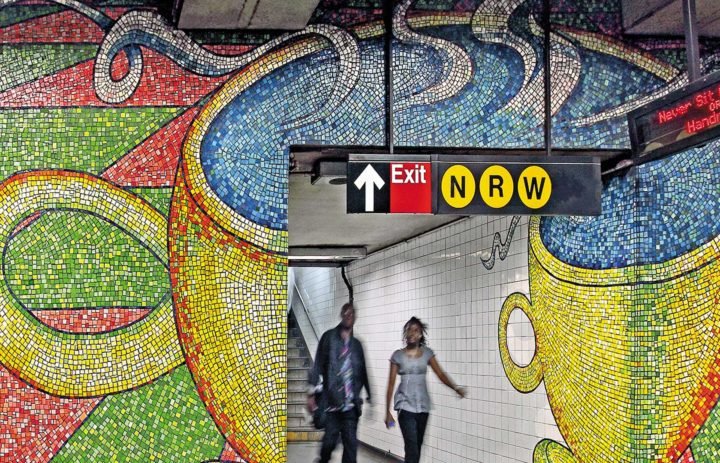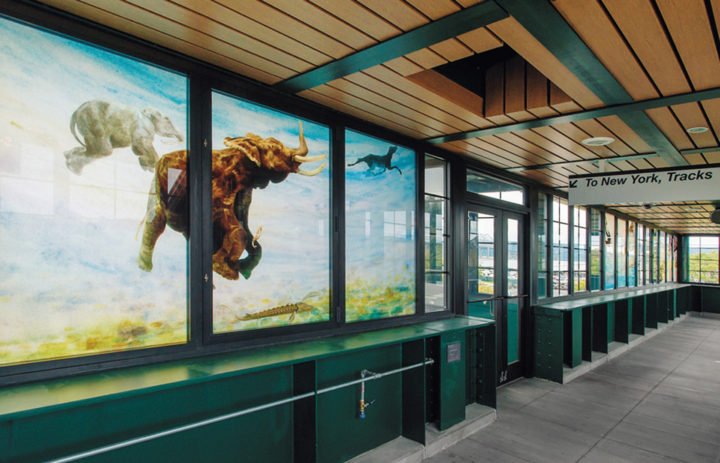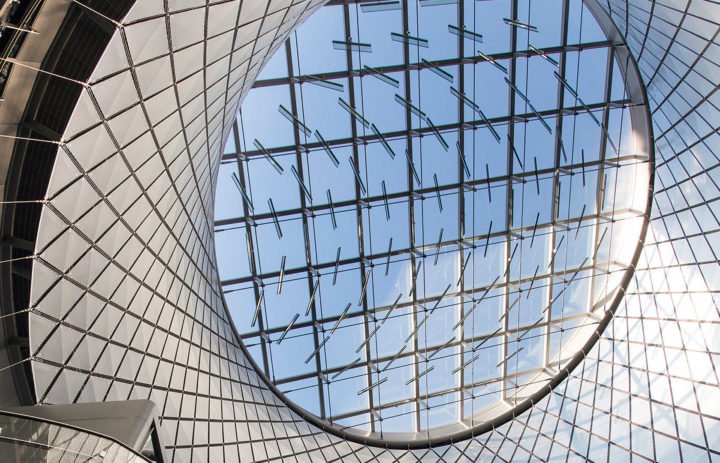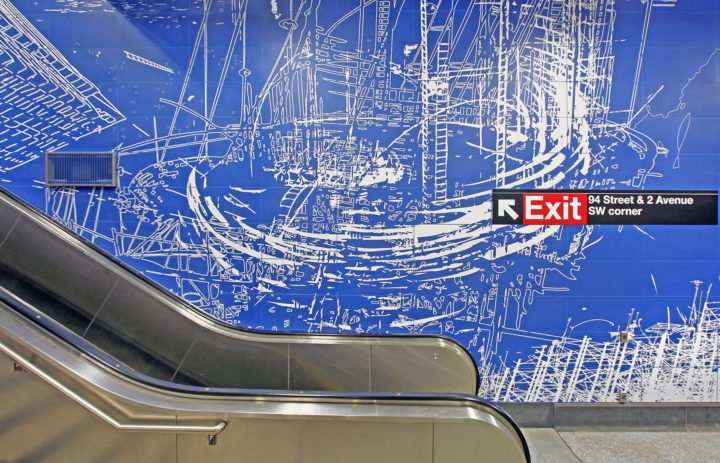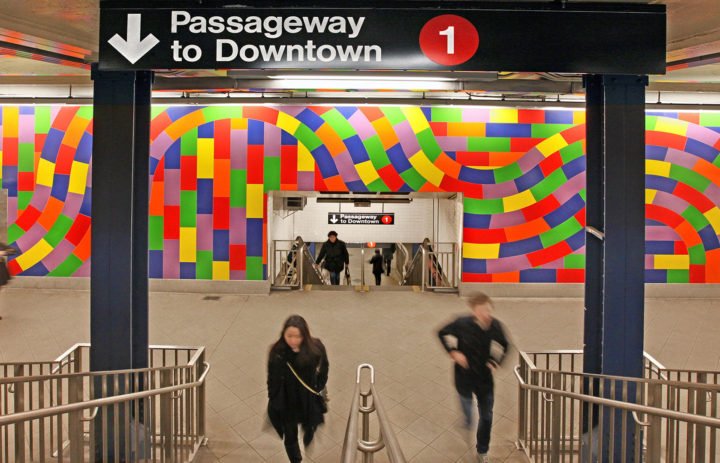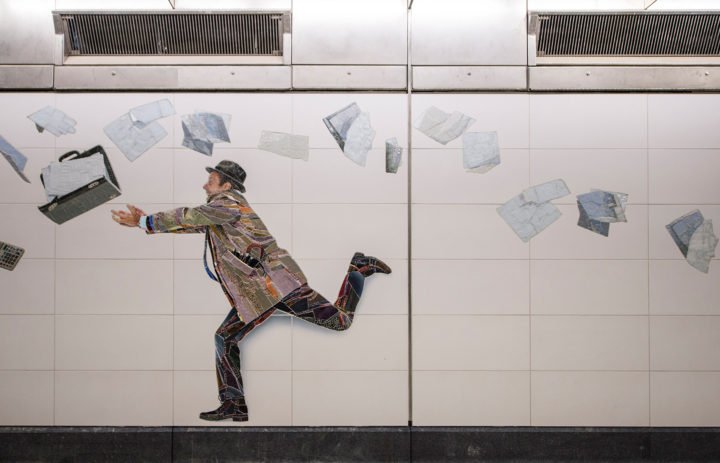The saying, life is about the journey, not the destination, could not be more evident than in New York City subways. While subways tend to suffer from the perception of being cramped and dirty spaces, the MTA (Metropolitan Transportation Authority) Arts & Design program has transformed the commuting experience for its 5.6 million daily riders by infusing subway stations with high quality art installations. Exquisitely curated and reflective of the diverse and passionate population that it serves, MTA Arts & Design has become a pioneer and the gold standard for the intersection between fine art and accessibility.
The following is an interview with Sandra Bloodworth, director of MTA Arts & Design.
Sandra Bloodworth (S): MTA Arts & Design (formerly Arts for Transit) was founded in 1985 as part of the MTA Capital Rebuilding Program. Percent for Art was signed into law in New York in 1982 and MTA leadership anticipated that the legislation’s requirement to allocate a percentage of the construction budget for public art would be extended to the MTA. In anticipation, MTA established the office of MTA Arts & Design and charged the office with commissioning public art for all station rehabilitation projects. Arts & Design was also immediately engaged with the role of advocate for high quality architectural and industrial design.
S: Initially, when MTA Arts & Design was founded and we were a fledgling organization, we learned a great deal – we learned what worked and what didn’t. By the mid-90’s, we had established our policy and procedures, and we had become pretty much the core of who we are today, and how we do business. We’ve learned a great deal from others and from looking at ourselves and at our environment. Now, over the years we’ve refined it: it’s a living, organic process and a lot is very unique. There have been some subtle changes, but what and how we do our work have become pretty much the standard around the country.
S: MTA Arts & Design has commissioned more than 300 permanent artworks in subway and commuter rail stations, and another 60 or so are in various stages of planning, selection, fabrication and installation at this time.
S: The most important thing about creating public art in our environment is that the work is durable. It must require little maintenance, and last for many, many years. The majority of the materials we approve “will last forever, if man nor nature doesn’t intervene.” Many of the projects we commission are fabricated in glass or ceramic mosaic, ceramic tile, bronze, laminated glass. That said, we continually push to expand the materials we use and the works we commission. At Fulton Center, we fully integrated the artwork into the architecture with “Sky-Reflector Net,” by James Carpenter Design Associates in collaboration with Grimshaw and Arup. There are always exceptions in the work we commission – we are able to experiment with different materials and media on a limited basis. For example, Leo Villareal created his LED light sculpture “Hive” at Bleecker Street. Works such as “Hive” have a shorter life span than mosaics but they also add a different type of magic to the subway, so we experiment with a few lighting projects, building into the plans that we will revisit in 20 years.
S: There is no doubt the inclusion of hundreds of works of art in the New York subway has changed the quality of life in people’s commuting experience. People know it is better and they feel good that someone cares enough about this place to include high quality art. That has changed the perception of the New York subway. Many people don’t remember what the subway was like when it was on the brink of collapse in the early 1980s. When we began installing art in that environment, it was a sign of hope that if you could turn around the subway, you could change what was happening in the city above. That if it hadn’t turned around underground, then changes above could never have happened. They went hand in hand.
S: When Arts & Design was founded, no one could have imagined that anyone – let alone an esteemed art critic – would ever refer to the New York subway as an art museum. But in 2012, an art critic for the New York Times, Randy Kennedy, wrote, “The most underrated art museum in New York City . . . has been the subway system.” So when we wrote the second edition of Arts & Design’s book on the art in the system, we titled it “New York’s Underground Art Museum.” When introducing art for the new Second Avenue subway, Governor Andrew Cuomo said, “The Second Avenue subway provides New Yorkers with a museum underground.” Go to any station on the Second Avenue subway and watch the people moving through the station. You will see people behaving as if they are in the Met or the MoMA, viewing the art and treating the space in the same way they would one of these revered institutions.
S: MTA Arts & Design was created to introduce original and integrated artworks into MTA stations and to promote design excellence as part the MTA’s effort to rebuild the transportation network. Today, Arts & Design oversees a number of programs that bring visual and performing arts to customers who use the entire MTA network, which includes subways, buses, commuter rails and the toll crossings within the city. The station art is known as the Permanent Art program, which commissions works of art into capital construction or renovation projects throughout New York City Transit, Metro-North Railroad, Long Island Rail Road and MTA Bridges & Tunnels. Arts & Design also showcases the work of photographers as part of our Lightbox Project, and the work of artists and illustrators through our Graphics Program, inspiring poetry through a collaboration with the Poetry Society of America for our Poetry in Motion program, and present thousands of musical performances annually at 25 subway and train stations through our Music Under New York program.
S: Art created for a Place and the People who use it.
S: The Arts & Design team curates through an extensive selection process that is defined by MTA policy, with the understanding that we’re procuring artwork.
We invite artists to submit through an open call. Most recently, artists are able to submit proposals online. We have meetings with a selection panel comprised of arts and cultural professionals and community advisors. Local community boards also participate in the process through representatives on the panel, so that they have a forum to express the concerns and aspirations of their community. We narrow down the field of artists to four finalists, who come in for an orientation on the project. We provide information on the location, the architects provide an overview of the design of the station, and we visit the site. The artists come back with a formal proposal. The voting panel selects the proposed artwork they believe speaks to the community and is of the highest quality.
This process has served us well. We have an amazing collection from a diverse group of artists, both emerging and established.
S: I am often asked this question. Every work is created for a particular place and the people who use that place, so each experience is unique and special. I have had the opportunity to meet and work with amazing artists and I have learned a great deal from them. In particular, Elizabeth Murray and Ann Hamilton taught me a great deal just through the opportunity to spend time in their presence. Artists of this stature and many others such as Roy Lichtenstein and Chuck Close have also brought such a spotlight to the collection that the interest of artists wanting to create art for us has multiplied tenfold.
S: New York is a melting pot, a diverse mix of people who take the subway everyday. The New York subway is the most diverse place on earth. It is our desire to reflect that diversity, but reflect it in ways beyond ethnicity. We have commissioned a mix of emerging artists, mid-career artists, and well-known artists. Some of the work speaks directly to a community and other works speak more to the broader community, and that is a wonderful thing. The work speaks to the people it is created for, those who use our transit system.
S: We strive to create thoughtful work that is created for the people who use that space, all the people that use it. While individuals may interpret works in a way that have a particular political intent or overtone, it is their interpretation and not the intent of the program. With more than 300 works of art installed in our system, someone is going to have an interpretation on some of the work that is different than intended. That is inescapable.
S: Public art programs are at their best when they subscribe to a set of best practices, embracing a fair and competitive process that results in a diverse and unique collection of artworks that speak to an equally diverse and unique population. The feedback we have received recently echoes the voices of those who use the system. Those who use the New York subway and commuter rail system get it that this work is created for them, that it is there for their experience, and that it was created through an artist’s vision of the artist but made for those who travel through this place.
We have an amazing team at Arts & Design. We work constantly to create opportunities for artists and to keep the work fresh and contemporary.
S: The visual and performing arts go hand in hand, creating cultural experiences within the transit environment. With our Music Under New York (MTA Music) program we present more than 7,000 performances annually in our subway and rail stations. Hearing music in the transit system can transform your day, as does poetry. With our Poetry in Motion program, a collaboration with the Poetry Society of America, we bring the words of award-winning poets to more than 6 million customers who ride MTA’s subways and buses daily.
S: MTA Arts & Design has grown over the years but the mission has remained the same. To improve the transit environment through the inclusion of public art. Arts & Design is interested in what the artist wishes to express, their ideas, their concepts. We are not looking for people to carry out our ideas but to bring theirs to the table. We are conscious not to limit artists through giving them a theme to develop an idea around. There is one consistent intent, that we mindful of the place and the people who use that place. That was our philosophy from the early days of the program and remains so today.
S: Over the past 31 years, MTA Arts & Design has fully integrated into the planning and design aspects of the MTA’s Capital Program, with MTA’s policy to allocate funds to ensure art is included in the system as we rebuild or build anew. As the MTA’s Capital Program grows, so does the commissioning of art. The new art at Second Avenue subway and the public’s reaction illustrates how powerful art is in the public realm. People were in tears reacting to the care and attention that went into creating unique transit stations. That is what the art did; it gave each station a unique identity that had been created for the people who use those stations and the surrounding community. The art itself carried that message, and it was well received by those for whom it was intended, New Yorkers and visitors alike.
- Featured image on the top: Art by Ming Fay – Photo Credit: Rob Wilson
- Photos courtesy of Metropolitan Transportation Authority Arts & Design
- For Want of a Nail (2000) Arts for Transit Collaborative, NYCT 81st Street–Museum of Natural History Station. Commissioned by Metropolitan Transportation Authority Arts & Design. Photo: Rob Wilson.
- Community Garden (2006) © Andrea Dezsö, NYCT Bedford Park Boulevard-Lehman College Station. Commissioned by Metropolitan Transportation Authority Arts & Design. Photo: Rob Wilson.
- Bees for Sunset Park (2012) © Christopher Russell, NYCT 9th Avenue Station. Commissioned by Metropolitan Transportation Authority Arts & Design. Photo: Stefan Hagen.
- Subway portraits (2017) © Chuck Close, NYCT Second Avenue–86 Street Station. Commissioned by Metropolitan Transportation Authority Arts & Design. Photo: Osheen Harruthoonyan.
- Eureka (2016) Dan Funderburgh, MNR Fordham Station. Commissioned by Metropolitan Transportation Authority Arts & Design. Photograph: Brian Kelley.
- See it split, see it change (2008) Doug & Mike Starn, NYCT South Ferry Station. Commissioned by Metropolitan Transportation Authority Arts & Design. Photo: Doug + Mike Starn.
- Blooming (1996) Elizabeth Murray, NYCT Lexington Avenue–59th Street Station. Commissioned by Metropolitan Transportation Authority Arts & Design. Photo: Rob Wilson.
- Hudson River Explorers (2012) Holly Sears, MNR Tarrytown Station. Commissioned by Metropolitan Transportation Authority Arts & Design. Photo: Michael Hnatov.
- Sky Reflector-Net (2014) © James Carpenter Design Associates, Grimshaw Architects, and Arup, Fulton Center. Commissioned by Metropolitan Transportation Authority Arts & Design. Photo: © David Sundberg/Esto.
- Elevated (2017) © Jean Shin, NYCT Lexington Avenue–63 Street Station. Commissioned by Metropolitan Transportation Authority Arts & Design. Photo: Rob Wilson.
- Hive (Bleecker Street) (2012) © Leo Villareal, NYCT Bleecker Street/Lafayette Street Station. Commissioned by Metropolitan Transportation Authority Arts & Design. Photo: James Ewing.
- Shad Crossing, Delancey Orchard (2004) Ming Fay, NYCT Delancey Street–Essex Street Station. Commissioned by Metropolitan Transportation Authority Arts & Design. Photo: Rob Wilson.
- Just Jazz (2015) Moe Brooker, LIRR Wyandanch Station. Commissioned by Metropolitan Transportation Authority Arts & Design. Photograph: Sid Tabak.
- Kaleidoscope (2012) Odili Donald Odita, NYCT NYCT 20th Avenue Station. Commissioned by Metropolitan Transportation Authority Arts & Design. Photo: Karen Mauch.
- Times Square Mural (2002) Estate of Roy Lichtenstein, NYCT Times Square–42nd Street Station. Commissioned by Metropolitan Transportation Authority Arts & Design. Photo: Rob Wilson.
- Blueprint for a Landscape (2017) © Sarah Sze, NYCT Second Avenue–96 Street Station. Commissioned by Metropolitan Transportation Authority Arts & Design. Photo: Rob Wilson; Trent Reeve.
- Whirls and Twirls (MTA) (2009) Sol LeWitt, NYCT 59th Street-Columbus Circle Station. Commissioned by Metropolitan Transportation Authority Arts & Design. Photo: Rob Wilson.
- Life Underground (2001) Tom Otterness, NYCT 14 Street–8th Avenue Station. Commissioned by Metropolitan Transportation Authority Arts & Design. Photo: Rob Wilson.
- Perfect Strangers (2017) © Vik Muniz, NYCT Second Avenue–72nd Street Station. Commissioned by Metropolitan Transportation Authority Arts & Design. Photo: Trent Reeve; Rob Wilson.
- Funktional Vibrations (2015) © Xenobia Bailey, NYCT 34th Street–Hudson Yards Station. Commissioned by Metropolitan Transportation Authority Arts & Design. Photo: Rob Wilson; Sid Tabak.




